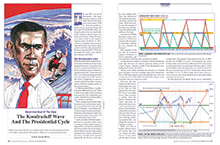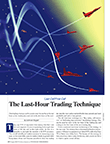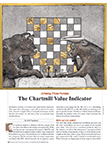LETTERS TO THE EDITOR
April 2013 Letters To The Editor
The editors of S&C invite readers to submit their opinions
and information on subjects relating to technical analysis and this magazine.
This column is our means of communication with our readers. Is there something
you would like to know more (or less) about? Tell us about it. Without a source
of new ideas and subjects coming from our readers, this magazine would not
exist.
Address your correspondence to: Editor, Stocks & Commodities,
4757 California Ave. SW, Seattle, WA 98116-4499, or E-mail to editor@traders.com.
All letters become the property of Technical Analysis, Inc. Letter-writers
must include their full name and address for verification. Letters may
be edited for length or clarity. The opinions expressed in this column do not
necessarily represent those of the magazine. —Editor
IN MEMORIAM
MARTIN ZWEIG 1942–2013
Martin Zweig, well-known investor, advisor, and analyst, who predicted the 1987 crash days before the sudden plunge, has died at the age of 70. Zweig, “whose newsletters influenced US investors for a quarter century,” according to Bloomberg.com, was interviewed in the April 1994 issue of Stocks & Commodities. He will be missed.
KONDRATIEFF WAVE
 Editor,
Editor,
Since Koos Van der Merwe’s last assessment of the S&P and Dow Jones Industrial Average was correct (“The Kondratieff Wave And The Presidential Cycle,” July 2012 S&C), we are wondering what his view is on where we are now in the K-wave. Was the 2009 low just early for the 2012 wave? Are the 2016 and 2019 highs our next targets, or has something changed in the wave count? Can we expect something different? We haven’t changed any of our stock positions and are profitable in all.
Can Merwe tell us his ideas on the US economy, the stock market, and his overall picture for 2014?
Doug
Author Koos van der Merwe replies:
See my article in this issue (“Reelections And The Presidential Cycle” beginning here), in which I revisit the Kondratieff wave and review the Presidential election cycle and update my market outlook.
I would say that this year will be a slow rise, as Congress keeps fighting President Obama. Things will improve going into 2014, and the market will be higher, but it won’t be an easy ride. I still see banks as being the best performer. However, by 2016, the market will be much higher, so have patience, and look carefully at what you invest in.
LAST-HOUR TRADING TECHNIQUE
 Editor,
Editor,
Thank you for Ashwani Gujral’s very interesting August 2012 article in S&C (“The Last-Hour Trading Technique”). These are the contributions that make the magazine worth reading and subscribing to.
I would like to ask him a question regarding his paragraph under the heading, “For Best Results.” What are his reasons for using Donchian channels and not Bollinger Bands?
Also, I’d like to know if he writes for any other magazines or websites.
Bayrd Inge Hamre
Author Ashwani Gujral replies:
Thanks for your gracious praise of my article.
I use Donchian channels just to make sure that the stock is coming out of a sideways pattern, which makes the move out of it more sustainable and powerful.
You can use Bollinger Bands if you are more comfortable with them, but the idea should remain the same.
I have written for almost every trading magazine in the US. These days I write once in a while for Stocks & Commodities when I discover something that works. As you know, a trader’s first job is to trade.
Hope this helps.
MORE ON LAST-HOUR TRADING TECHNIQUE
Editor,
I enjoyed reading Ashwani Gujral’s article in the August 2012 Stocks & Commodities. Like Gujral, I am also a portfolio manager from Singapore.
My question on his article is: May I ask what tenure he has tested this for?
Bernard Tang
Author Ashwani Gujral replies:
I am glad you enjoyed reading the article.
The methodology has been rigorously tested with real money over the last couple of years and is likely to work at all times, since every day you have momentum in some area of the market, either up or down — the methodology just plays on those natural tendencies.
CHARTMILL VALUE INDICATOR
 Editor,
Editor,
I created a spreadsheet using the formulas shown in the sidebar in part 1 of Dirk Vandyke’s recent three-article series (“The Chartmill Value Indicator,” January 2013 S&C) with the SPY data of the interval given in the article. (I did this despite the fact that the true range does not match Wilder’s calculation.) Unfortunately, I got nowhere near the values shown in Figure 2 of the same article. Was there something missing in the sidebar calculations?
In addition, in part 2 of the article series (February 2013) the author states, “... there are no parameters involved in its equation...” yet the sidebar formulas of part 1 have an “x” in the calculation. Isn’t that a parameter?
James A. Olson
Author Dirk Vandyke replies:
As to the parameter: You may be right, but as the indicator is fit to short-term consensus, the x is hardcoded to 5 (periods/days). I did not seem to get far better or worse signals experimenting with x being 4 or 6 or 12 ... so it’s arbitrarily chosen to be five periods on the daily time frame (as there are five days in a week). In other than the daily time frame, I would love to see the community pick on that and test the CVI more thoroughly.
Thank you for your questions. After all, discoveries usually don’t start with “Eureka!” but far more often with “That’s strange...”
Originally published in the April 2013 issue of Technical Analysis of Stocks & Commodities magazine. All rights reserved. © Copyright 2013, Technical Analysis, Inc.
Return to
Contents
 Editor,
Editor, Editor,
Editor, Editor,
Editor,